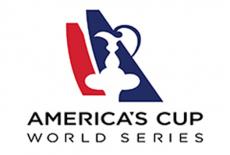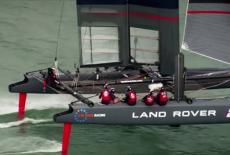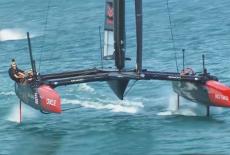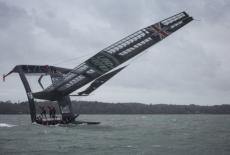Americas Cup World Series 2016 - AC45

23.12.2015
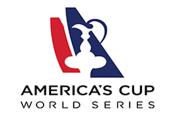
Americas Cup World Series 2016
The Americas Cup World Series (ACWS) are match and fleet racing regattas held in 2015 and 2016 as the lead up to the 2017 Americas Cup.
The ACWS uses AC45 catamarans, a one-design 45 foot wingsail catamaran with foils designed for the event by the Oracle Racing engineering team. The AC45 is a smaller version of the 72 foot AC72 Class catamarans which were sailed by 2013 Americas Cup competitors.
The AC45 class was modified in 2015 to incorporate hydrofoiling capability for improved performance, with boats achieving speeds of over 30 knots.
Confirmed Americas Cup World Series Regattas in 2016
- Muscat, Oman – February 26 to 28
- New York, USA – May 6 to 8
- Chicago, USA – June 10 to12
- Portsmouth, UK – July 22 to 24
- Toulon, France – September 10 to 11
AC45 are Designed To Fit in a 40 Foot Shipping Container
The modular design had to be easy to assemble and disassemble to accommodate the active racing schedule and also to fit inside a 40 foot container for shipping. It had to be robust enough to sail through a wide wind range, from 5 to 30 knots, and also survive in the event of collisions.
The AC45 is built of honeycomb core carbon fiber sandwich by Core Builders and Cookson Boats of New Zealand. Length is 13.45 metres (44.1 feet), beam is 6.90 metre (22.6 feet). Maximum draught is 2.7 metre (8 feet 10 inch) and air draught is 21.5 metre (71 feet) without extension, 25.5 metre (84 feet) with extension.
Spectacular videos of AC45 Foiling Catamarans riding on the edge >
Bermuda Will Be Home of the 2017 America's Cup
The next America’s Cup will be raced in Bermuda in June of 2017. Harvey Schiller, Commercial Commissioner for the America’s Cup, said, “The 2017 America’s Cup will build on the successful elements that now define the event - close racing in fast, foiling catamarans crewed by the very best sailors in the world. In Bermuda we have a perfect international venue to demonstrate the excitement that America’s Cup boats and teams can generate. The sailing conditions are near perfect and the race course on The Great Sound is a natural amphitheater with room for racing and spectators..."
The new America’s Cup Class rule is the result of teams feeding in suggestions to American multihull designer Pete Melvin, who was contracted by Regatta Director Iain Murray to draft the rule.
ORACLE TEAM USA tactician Tom Slingsby projects the performance we will be seeing from the new America’s Cup Class, wingsail, foiling catamaran, “By the time the America’s Cup comes around in 2017, we’re going to be seeing two boats going head to head, foil-tacking all around the place, trying to break cover on the foils. It’s going to be incredible for those of us on the boat and it will be spectacular to watch.”
“I think all of the teams who have been sailing the so-called AC45 ‘turbo’ boats over the past few months have been surprised by the performance they’ve seen, which is partly what inspired this idea of a new, smaller class,” Slingsby says. “In our boat we were doing roughly the same speed as the 72 when the breeze was up and we were maybe a little faster than the 72 in lighter winds.
“Over the past few weeks most of the teams have been back and forth with Pete Melvin, giving our opinions on what works well on these boats. He’s taken all of this input and come up with the new America’s Cup Class. The changes in this rule compared to the boat we sailed, for example, is improved hull shape and configuration and there are much tighter restrictions on manual power as well as the extra length.
“The new class is going to be an amazing boat. The boat we sailed in San Francisco was excellent. It was manoeuvrable, fast and reacted well and the new class will be a step on from that. It’s hard to describe just how much fun boats like this are to sail and to race,” he says. “They’re incredibly challenging, but the idea that we’re doing things that haven’t been done before adds to that excitement.”
The new America’s Cup Class will be crewed by just six and Slingsby says there’s no room for passengers. All power on board to control the wing and foils must be generated by the sailors through two grinding pedestals that push oil to an advanced hydraulic system.
“These boats are going to be incredibly physical, being completely crew powered,” Slingsby said. “For a sailor, that’s very exciting. There is no room for deadweight. You’ll have to be very fit and extremely smart to sail these boats. As tactician, I’ll have to be grinding as well. The only guys not grinding will be the helmsman and the wing trimmer. I think it’s the most physical America’s Cup boat we’ve ever seen.
The Design Race behind the America’s Cup boats
“One of the main areas where designers will impact performance is with appendage design, control and structure - the foils,” Slingsby said. “Different shapes make a major difference. For example, the little changes we made from the 72 down to the 45 we tested in February had a massive impact. We made some refinements to the shapes and improved the appendages and we hit close to 46 knots of speed in 16 knots of wind in a 45-footer. So we made a good step there, but I think there is a lot more to be gained still.
“The wing rule is exactly the same as it was for the 62 (albeit scaled down), with the geometry defined, but the control systems completely open. Again, I think you’ll see a lot of different ideas from the teams here. There are gains to be made in ease of use, how the boat manoeuvres, how the wing pops through on tacks and gybes. If we start considering foil-tacking for example, this area becomes so important. Having excellent control systems for the wing and appendages is critical.
“And then we look at aerodynamics, which is also wide open for this boat. When you’re going upwind at 30 knots with 20 knots of wind over the deck, that’s a 50 knot headwind, so you can imagine what a difference aerodynamics will make. I think we’ll see different ideas here too."
The tight race courses the teams will compete on will also put a premium on having reliable, advanced control systems. Having systems that allow you to push the envelope to go to places we’ve never been before - foil-tacking a catamaran - that’s absolutely huge. The designers will be working overtime trying to figure this stuff out. I think the new boats are going to look different, they’re going to perform differently and the designers have plenty of room to explore. I can’t wait to get my hands on ours!”
All images are copyright RIB & HSC 2024 unless otherwise stated.
This does not exclude the owner's assertion of copyright over the material.
05.04.2024
Hydro Motion - H2 from NL to England in 2024
The TU Delft Hydro Motion Team wants to cross to…
05.01.2024
The Challenges of Unpredictable Marine Energy
From military to superyacht, it is clear there is an urgent…
Speed@Seawork 2024
Dates:
10th June 2024
Location:
Cowes, Isle Of Wight,
Foiling and Flying RIBs
Foiling powerboat designed to meet military needs - fast, stable, silent, fuel-saving. Collaboration by SEAir Foiling Systems and Sillinger RIBs.…














